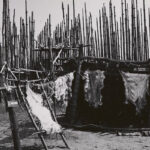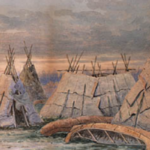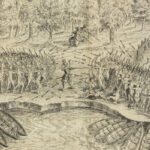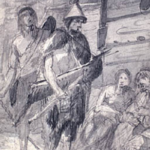The Indigenous Nations and First Nations Bands of Saskatchewan: A Historical Overview
Saskatchewan’s Indigenous Nations form a vital chapter in the history of Canada’s Great Plains, embodying a rich tapestry of cultural, political, and spiritual traditions. This prairie province is home to 74 First Nations bands representing several cultural groups, including the Cree (Plains and Woodland), Dene, Saulteaux, Dakota, Lakota, Nakota, and Métis. Each group’s history is interwoven with the land’s vast grasslands, boreal forests, and rivers, shaping a way of life deeply rooted in the environment. This article explores their pre-European contact lifestyles, political systems, social structures, religion, origin stories, warfare, and food sources.
Pre-European Contact Lifestyle
Before European contact, the Indigenous peoples of Saskatchewan thrived in one of the most ecologically diverse regions of North America. The Cree and Saulteaux peoples dominated the forested northern areas, relying on hunting, trapping, and fishing for survival. Moose, beaver, and fish were staple resources, while the seasonal availability of berries and wild plants supplemented their diets.
On the southern plains, the Plains Cree, Dakota, and Lakota centred their lives around the vast herds of bison that roamed the grasslands. The bison provided food, shelter, and tools, with hides used for tipi covers and clothing, and bones crafted into tools and weapons. The Métis, a distinct cultural group of mixed Indigenous and European ancestry, emerged as skilled hunters and traders, blending Indigenous practices with European technologies (Brown, 1992).
Seasonal migrations were a hallmark of these groups, dictated by animal movements and resource availability. The annual bison hunt was a central event for the Plains peoples, involving entire communities in coordinated drives. The use of buffalo pounds and jumps, such as those near Moose Mountain, highlights their ingenuity and deep ecological knowledge (Mandelbaum, 1979).
Social Structures and Slavery
Saskatchewan’s Indigenous societies were organized into bands or extended family groups. Leadership often emerged through consensus, with chiefs and councils guiding decisions based on experience and respect. Among the Cree and Saulteaux, the role of leaders extended to mediating disputes, ensuring equitable resource distribution, and maintaining peace with neighbouring groups.
While slavery existed among some Indigenous groups, it differed significantly from the institutionalized systems seen elsewhere. Captives taken during intertribal conflicts were often assimilated into their captors’ communities, sometimes gaining full membership over time (Brown, 1992). This practice reflected a more fluid concept of identity and belonging, rooted in kinship rather than rigid hierarchies.
Politics and Warfare
Political systems among Saskatchewan’s Indigenous peoples were decentralized, with governance typically occurring at the band level. Leaders were chosen based on their ability to maintain harmony and ensure the community’s survival. Among the Plains Cree and Dakota, alliances were common, both within and across nations, to manage shared resources and protect against external threats.
Warfare was a feature of life on the Great Plains, often sparked by territorial disputes, resource competition, or the need to assert dominance. Plains warfare, however, was highly ritualized. Raids often aimed to acquire horses or demonstrate bravery rather than annihilate enemies. Historian John Tobias noted that “warfare among the Plains peoples served as a way to build alliances, test leadership, and maintain social cohesion” (Tobias, 1983).
Religion and Origin Stories
Spirituality was central to the lives of Saskatchewan’s Indigenous peoples, deeply tied to their environment. The Cree and Saulteaux viewed the natural world as alive with spirits, each with distinct powers and roles. Ceremonies like the Sun Dance reflected their cosmology, emphasizing renewal, community solidarity, and balance with the natural world.
Origin stories provided moral and cultural frameworks. Among the Cree, the tale of Wisakedjak, a trickster figure, illustrates themes of creation, survival, and human responsibility to the Earth. These narratives were passed down orally, ensuring their preservation and relevance across generations.
Food Sources and Trade
The Indigenous peoples of Saskatchewan relied on a diverse array of food sources, adapted to the province’s ecological zones. On the plains, bison were the cornerstone of life, supplemented by deer, elk, and smaller game. The preparation of pemmican, a mixture of dried bison meat, fat, and berries, ensured food security during lean seasons and became a key trade item with European fur traders.
In the northern forests, fishing provided a reliable source of protein, while the harvesting of wild rice, berries, and medicinal plants diversified diets. The rivers and lakes of Saskatchewan were crucial for both subsistence and transportation, connecting communities and enabling trade networks.
Trade networks extended beyond Saskatchewan, linking Indigenous groups across North America. The Métis played a pivotal role in these networks, acting as intermediaries between European fur traders and Indigenous trappers. The Hudson’s Bay Company and North West Company relied heavily on Indigenous expertise to sustain their operations (Brown, 1992).
Contact with Europeans and Its Impact
European contact in Saskatchewan began in earnest during the late 17th century with the expansion of the fur trade. This contact brought profound changes, including the introduction of European goods such as firearms, metal tools, and textiles. While these items enhanced certain aspects of life, they also disrupted traditional practices and increased competition for resources.
The arrival of European settlers also introduced devastating diseases like smallpox and measles, which decimated Indigenous populations. Residential schools and policies aimed at assimilation further eroded cultural practices and languages, leaving lasting scars on Indigenous communities (Tobias, 1983).
Legacy and Resurgence
Today, Saskatchewan is home to a vibrant Indigenous population, with 74 First Nations bands and several Métis communities actively working to preserve and revitalize their cultures. Organizations like the Federation of Sovereign Indigenous Nations (FSIN) advocate for land rights, education, and cultural programs, reflecting the resilience and determination of these communities.
Language revitalization efforts, traditional ceremonies, and land stewardship initiatives demonstrate a commitment to preserving heritage while addressing contemporary challenges. The story of Saskatchewan’s Indigenous peoples is one of resilience, adaptation, and enduring connection to the land.
Conclusion
The Indigenous Nations and First Nations bands of Saskatchewan exemplify the richness of Canada’s cultural history. From their intricate pre-European societies to their profound contributions to trade and culture, they have shaped the province in immeasurable ways. As historian John Tobias eloquently stated, “The history of Saskatchewan’s Indigenous peoples is not a tale of survival alone but a testament to the strength of communities deeply rooted in tradition and innovation.” Their legacy continues to inspire, offering lessons in resilience, adaptability, and stewardship.
References
- Brown, J. S. H. (1992). Loyalties in Conflict: A Canadian Borderland in War and Rebellion, 1812-1840. McGill-Queen’s University Press.
- Mandelbaum, D. G. (1979). The Plains Cree: An Ethnographic, Historical, and Comparative Study. University of Regina Press.
- Muckle, R. J. (2011). The First Nations of British Columbia: An Anthropological Overview. UBC Press.
- Tobias, J. L. (1983). Protection, Civilization, Assimilation: An Outline History of Canada’s Indian Policy. Journal of Canadian Studies.



